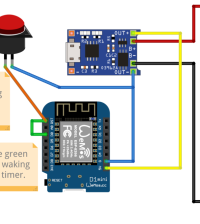- makeITcircular 2024 content launched – Part of Maker Faire Rome 2024Posted 2 weeks ago
- Application For Maker Faire Rome 2024: Deadline June 20thPosted 2 months ago
- Building a 3D Digital Clock with ArduinoPosted 7 months ago
- Creating a controller for Minecraft with realistic body movements using ArduinoPosted 7 months ago
- Snowflake with ArduinoPosted 8 months ago
- Holographic Christmas TreePosted 8 months ago
- Segstick: Build Your Own Self-Balancing Vehicle in Just 2 Days with ArduinoPosted 8 months ago
- ZSWatch: An Open-Source Smartwatch Project Based on the Zephyr Operating SystemPosted 9 months ago
- What is IoT and which devices to usePosted 9 months ago
- Maker Faire Rome Unveils Thrilling “Padel Smash Future” Pavilion for Sports EnthusiastsPosted 10 months ago
Vinduino, a wine grower’s water saving project

If you want to learn about saving water, talk to a farmer. California farmers, including myself, voluntarily aim to reduce agricultural water consumption by 25%. This reduction (25% of 42 million acre feet/year) is more than the annual urban water use (8 million acre feet/year), much more effective than any residential water reduction can achieve. The Vinduino project (Vineyard + Arduino) started out of necessity to better manage irrigation in my Southern California vineyard. In order to be of the greatest possible use to the public, the Vinduino project is open source, affordable, and easy to build.
In 2015 we saved 25% , or 430,000 gallons, of irrigation water.
Cost saving on water and labor was $1,925.
Cost to achieve these savings was $635.
Minimum configuration for developing countries, incl. salinity measurement: $ 60.36 countries are now classified as severely drought affected.
Saving water makes all the sense in the world. Hope you will be inspired too!!

How does it work?
Using a single soil moisture sensor, you can determine when to start irrigation, but overwatering is hard to avoid. This is illustrated with the animation below. By the time the irrigation water reaches the sensor, the layer above is saturated and likely there is more water than the plant can consume. The surplus water will now seep below the root zone, out of reach of the plant, taking unused nutrients with it as well.
By using multiple sensors, located at different depths, you can actually control irrigation to not exceed the active root zone,
and thus save water. Rather than to irrigate for long periods and have long periods between irrigations, it’s better to have short, frequent irrigation events. The plant will be able to take up the irrigation water before it has a chance to reach the level below the active root zone. Sensor 3 should be located lower than most of the active root system. When sensor 3 sees high moisture levels, its a signal to reduce water/increase interval frequency. Sensor depth and watering schedule depends on the type of crop and growth cycle.
For vineyards, irrigation reduction is sometimes practiced in the period before harvest to get highly concentrated wine grape material. The idea is that the best wines come from vines that have suffered water stress.
Resistive sensors, like gypsum or Watermark sensors, need to be excited with short pulses of alternating current to avoid electrolysis effects. The Vinduino interface alternates current through the sensor, and two analog inputs are used to measure voltages over the bridge. This compensates for differences in (battery) supply voltage, and also allows to compensate for sensor bias voltage.
A lesser known fact is that sensors can act as small batteries due to a galvanic effect caused by a difference in concentration within the sensor.
Because the sensors are connected together through a soil resistance path, multi-sensor measurements can only be done when sensors are disconnected when not in use. Vinduino uses regular 2N7000 FETs for this. The handheld reader can measure only one sensor at a time, and therefore can use a simpler interface circuit without FET switches.

More details here: Hackaday.io
















